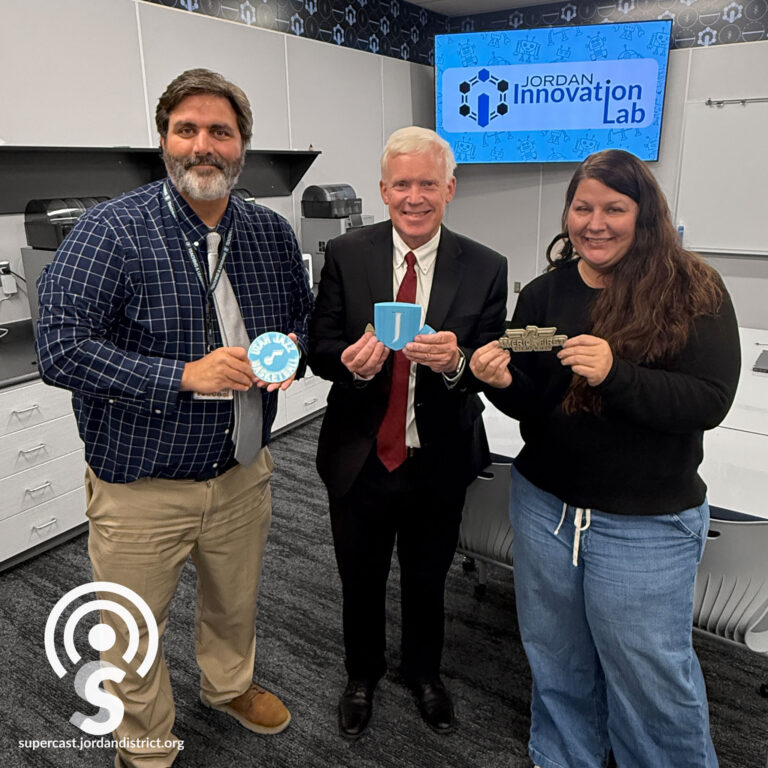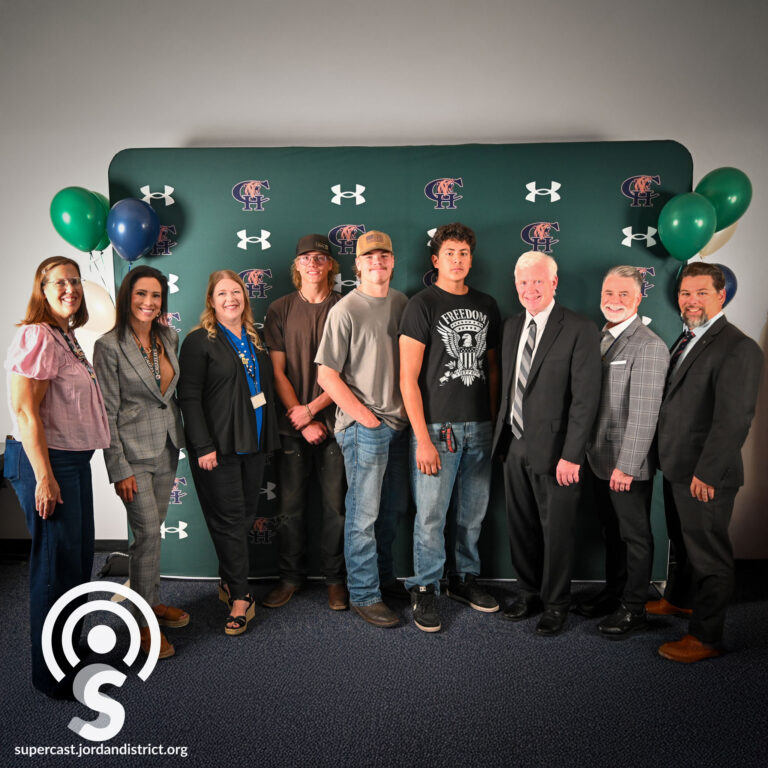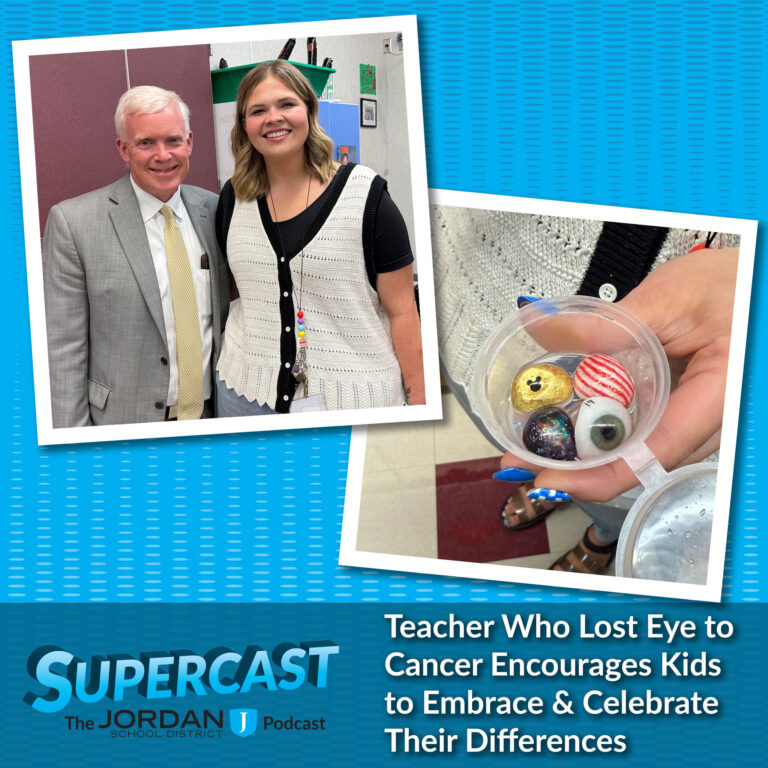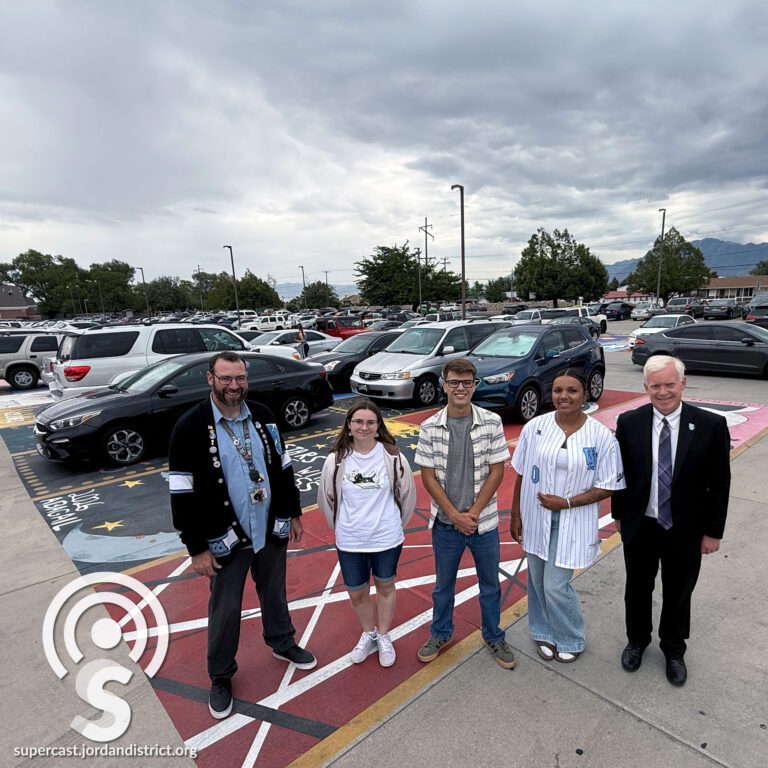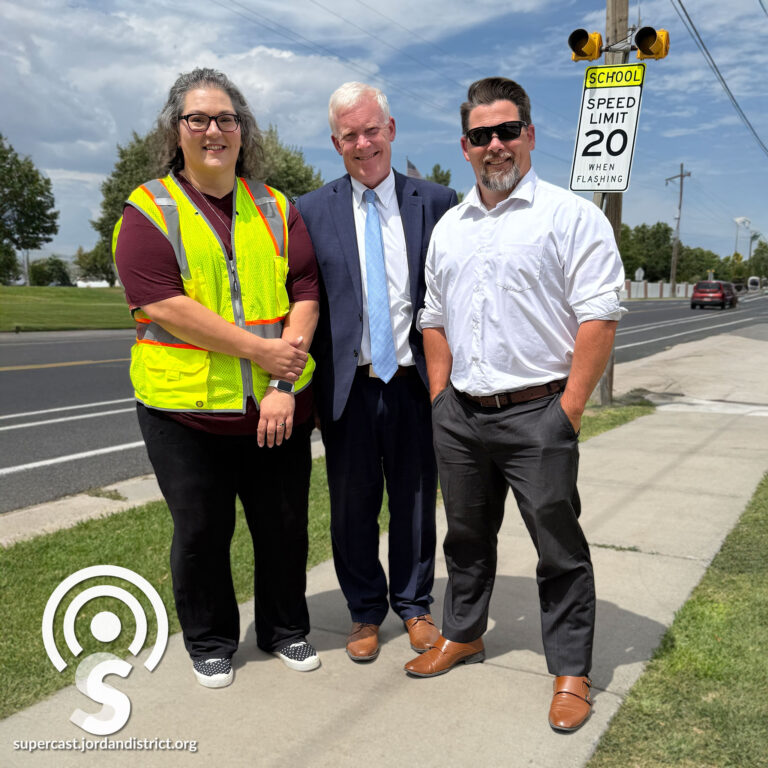It is a ‘first-of- its-kind’ High Tech Learning Lab for elementary school students in Jordan School District made possible through a partnership with the Utah Jazz, Utah Mammoth and America First Credit Union.
On this episode of the Supercast, we take you inside the Learning Lab where students are wild with excitement over 3D printing, stop motion robotics, coding, and so much more. Listen and you will hear the sounds of technology hard at work.
Audio Transcription
Traci Rindlisbach:
We thought that was so exciting to give the kids a chance to 3D print. Not just pressing a button, they're going to start modeling their prints.
Jared Covili:
We want students not to just be technology consumers where they just use it to find the latest game or the latest trend online. We want them to become technology creators and that's the core of what this space is.
Anthony Godfrey:
Hello and welcome to the Supercast. I'm your host, Superintendent Anthony Godfrey. It is a first-of-its-kind, high-tech learning lab for elementary school students in Jordan School District, made possible through a partnership with the Utah Jazz, Utah Mammoth, and America First Credit Union. On this episode of the Supercast, we take you inside the learning lab where students are wild with excitement over 3D printing, stop-motion robotics, coding, and so much more. Listen and you will hear the sounds of technology hard at work.
Anthony Godfrey:
We are at Juniper Elementary School, home of the Jordan Innovation Lab, with two of the people who helped make this possible. Please introduce yourselves and let's get right into it.
Traci Rindlisbach:
Hi, I'm Traci Rindlisbach. I work for Digital Teaching and Learning and I got to help set up the Innovation Lab.
Jared Covili:
My name is Jared Covili. I'm the administrator over the Digital Teaching and Learning Department and I'm just a fan of the Innovation Lab.
Anthony Godfrey:
I am a fan too. I just walked in, but I've heard so much about it and I was not able to be here for the ribbon cutting, but so many great reports about student reactions and the reactions from the donors who made it happen. But let's jump right into a project. Let's not just talk about it. Let's get down to business. So we have 3D printers all the way along this wall and you've 3D printed a bunch of things already for the launch. Tell me about that and tell me about the project we're going to do right now.
Traci Rindlisbach:
All right, so we bought two different types of 3D printers. We bought these Bamboo Lab 3D printers, which are super exciting because you can print four different colors and these are a little more serious 3D printers. Then we have these tiny toy boxes as well that are just like super fast prints and just like you're dipping your toes in there to start a print.
Anthony Godfrey:
So I didn't even see the little ones in between. So yeah, wow. So we've got 10 of them right here.
Traci Rindlisbach:
Yeah.
Anthony Godfrey:
That's amazing that this is a this is a playground for kids to well for you, too. This is this is this is pretty exciting. So what's our what's our project here?
Traci Rindlisbach:
Okay, so on this Bamboo printer, we've printed a whole bunch of things like when we were opening, we printed like the Jordan shield two colors, the Mammoth logos and the Jazz logos. All those logos were printed. We're just going to have you print a guitar pick for yourself since we know you're all about playing guitar.
Anthony Godfrey:
Absolutely.
Traci Rindlisbach:
So the first thing you're going to do is you're going to hit this file right here.
Anthony Godfrey:
Okay, so I'm accessing the templates or the designs.
Traci Rindlisbach:
These are just all the G codes like put on there and there's your pick right there.
Anthony Godfrey:
Yeah, that's perfect.
Traci Rindlisbach:
Yeah, just click that.
Anthony Godfrey:
So click on that.
Traci Rindlisbach:
Then the PLA we've chosen . . .
Anthony Godfrey:
It has a nice edge for gripping the . . That's a well-designed pick. That was a well-designed pick. Absolutely. I can really wail with this one.
Traci Rindlisbach:
Okay. And so we're going to do this metal PLA because we tested it with the other one and it broke.
Anthony Godfrey:
So okay, this is like choosing letter or legal paper.
Traci Rindlisbach:
Yeah.
Anthony Godfrey:
Yeah, except we're going to choose the right and so which, which one . . .
Traci Rindlisbach:
Right here this print now.
Anthony Godfrey:
Print now. You've already set it up to print like .
Traci Rindlisbach:
Yeah, you just set it. We can click right here and you can choose the different PLAs.
Anthony Godfrey:
Okay, right there.
Traci Rindlisbach:
And then it's good to go. And it's going to be printed in. See right here. 13 minutes.
Anthony Godfrey:
13 minutes. Okay, we're at 0%. Temperature 69 Celsius. Okay, we're going up.
Jared Covili:
You're going to be able to add this to your resume. You're now officially a maker of a metal guitar pick.
Traci Rindlisbach:
You can sell these at your shows.
Jared Covili:
You can start your own Etsy shop.
Anthony Godfrey:
This is the one I won't flip out into the crowd. Okay, we will let a watch pot never boils and a watch print never comes to fruition. So we're going to let that simmer while we talk a little bit about how the lab started. So we were contacted by the Smith Entertainment Group, Utah Jazz, the Mammoth and America First [Credit Union] with the concept of building something that was centered around innovation, something unique for students. What excited me is that they knew that was generally in the STEM area, but it felt like there was going to be a lot of flexibility in how we shape that. So talk to me about how we decided what to do and what that partnership look like.
Jared Covili:
Yeah, we were approached by Mike Haynes from the Jordan Education Foundation, probably in May. He mentioned the idea that the Smith Entertainment Group and America First Credit Union wanted to help us build something that could really enhance students’ education. They said, “you know, we want it to have kind of an innovative blend to it, right? So we're not looking for traditional forms of learning. We'd like to use technology.” And immediately Traci got involved. She's one of our people that's very involved in STEM and computer science in our District. So we started talking about what would be some of the great tools that we could provide kids with this additional funds. We wanted to give them an experience that they couldn't have at their regular at the regular school.
Anthony Godfrey:
So what made you go this direction and tell me about what's here?
Traci Rindlisbach:
My STEM partner, Kelly Cannon, she works in the same department as I do. We have been really into 3D printing since we both came into this role. We thought that is so exciting to give the kids a chance to 3D print because it's like not just like pressing a button. They're going to like start modeling their prints and doing all those like engineering design processes through just learning how to 3D print and 3D printing.
Anthony Godfrey:
So what does it mean to model for those who haven't done 3D printing before?
Traci Rindlisbach:
That's a great idea. Create their prints. So they'll go into some kind of program. They could go into Tinkercad or on these toy boxes you can do modeling inside the app of itself. And so you'll just go and create whatever you want inside there and send it to this little printer and it will print what you've done. Now will it be perfect? Maybe if you did it correctly. But there's also that fun element of like they're going to go back and iterate and say, “oh, that didn't work. I'm going to fix this and this and this on my print until it's perfect.”
Anthony Godfrey:
Is that why we have the smaller printers so that they can dabble and kind of test things out before they go to the multi color printer or do they dive right in?
Traci Rindlisbach:
It's really an either situation like they could start on the toy box if they felt more comfortable with that. This is like a more entry level like modeling system. You'll just pull some shapes in and you'll start joining your shapes. You could pull in photos and you can make some lithographs where like if you put a light behind it, it shows like whatever photo you put into there. On the Bamboo, they would be modeling probably in Tinkercad and that would be a little more serious modeling, but still with shapes and things. So this one's just a more friendly model to get started with. But we did have a student on opening day who was really stoked about the Bamboos and talked about his Bamboo at home and what he's doing at home. So I think there's going to be kids coming in who've had a lot of experience with 3D printing and they're going to be able to teach the other students as well.
Anthony Godfrey:
OK, and tell me again, how do you model something? Do you is that essentially designing it virtually so that it can then become something that is physically tangible in the real world?
Traci Rindlisbach:
Yes, that's a good question. So in Tinkercad they would like design it inside the Tinkercad program and then they would slice it on the slicer and then put it right in here and it would print on out.
Anthony Godfrey:
So in other words, students can come up with their own projects and design it from start to finish instead of simply printing something that somebody else already designed.
Traci Rindlisbach:
Yes, that's what we want them to do. Like we want them to like, of course, they could come in and make a print and that's always exciting. Just learning the process of how to do it. But like we want them to get to the point where they're modeling things.
Anthony Godfrey:
Maybe seeing a print initially motivates them to do all that modeling work that will lead them to something that they created themselves from scratch.
Traci Rindlisbach:
A hundred percent. We want our students to come in and choose a project that they're going to do. It could be like 3D printing or stop motion or we also have an engineering one where we'll be modeling and like creating things with cardboard. So we want them to come in with content knowledge already. So we'll say we're working in fourth grade on Mormon Pioneer Trail. They come in and they can choose if they're going to do a 3D print project, a stop motion project, or an engineering project based around the content they learned in their class. So this is just like project based learning at its best.
Anthony Godfrey:
So any of those three approaches could be used to create a project around really any subject matter.
Traci Rindlisbach:
Yes.
Anthony Godfrey:
So this connects to any learning that's happening in the classroom. That's really exciting.
Traci Rindlisbach:
That's why we're so excited about it because it's not just come and print whatever. It's come and print with a purpose.
Anthony Godfrey:
Yeah. Stay with us when we come back more about the Innovation Learning Lab at Juniper Elementary School.
Male Voice:
Never miss an episode of the Supercast by liking and subscribing on your favorite podcasting platform. Find transcripts for this episode and others at supercast.jordandistrict.org.
Female voice:
Does your child need the flexibility to learn from anywhere at any time on a cruise, in another country or simply at home cozy on the couch? The Jordan Virtual Learning Academy is tailor made for you and your family. It's personalized dynamic virtual learning on your schedule. The Jordan Virtual Learning Academy is an integrated system of three schools in Jordan School District: Rocky Peak Virtual Elementary School, Kelsey Peak Virtual Middle School and Kings Peak High School. Our programs are designed to meet or exceed district and state core curriculum standards, ensuring your child receives a superior educational experience tailored to their needs. Join us today at JordanVirtual.org.
Anthony Godfrey:
Tell me about the three projects that students can do here in the Innovation Lab.
Traci Rindlisbach:
So we talked a whole bunch about the 3D printing. So our next one is Stop Motion and the educator that we've hired to be in charge of the lab, she is huge into stop motion and so we're super excited that she's going to be here. Her name is Tori Hadley. The students will come in with whatever content they've learned in class and they'll be given an iPad and a stand and they'll just get to work. We'll have them storyboard like “what are you guys going to do? What's the content?”
Anthony Godfrey:
Essentially the comic book version of what they're going to film.
Traci Rindlisbach:
Absolutely and then they'll start filming it. So we have all these card all this cardboard that we've sourced from Juniper, which is great.
Anthony Godfrey:Yeah nice to be housed in an elementary school that's well stocked.
Traci Rindlisbach:
Then we just have this paper and then we have these little figures over here. They could make their own characters or they could choose from our characters.
Anthony Godfrey:
Oh yes, some of these figures. So, if you can combine these the trolls and dinosaurs and others into a storyline you can do that. Well, there's a bear and a horse as well. Sure, we can come up with some sort of a fairy tale there.
Traci Rindlisbach:
Oh for sure.
Anthony Godfrey:
Now you've got this cardboard and now chompsaw. I'm sure many student eyes light up at the phrase chompsaw. So show me what a chompsaw does. I have some inkling as I look at this device.
Traci Rindlisbach:
So we bought these after we saw them because we were so excited. They're student safe so I'm going to turn this on and you can see like nothing's going to . . .
Anthony Godfrey:
Right, you put your hand right up against it and you're okay.
Traci Rindlisbach:
So when the students decide what they want to chomp, when they decide what they're going to do. And this could be for their background it could be for their character or whatever. They'll sketch it out and they'll just throw their chompsaw on. This also cuts paper which is really exciting. We didn't know that after we bought it we found out.
Anthony Godfrey:
So you take the cardboard and you can shape the cardboard. Oh wow that's a cleaner cut than I expected. So this is essentially for those. It's like a . . . I don't know. There's a little knob on top here that spins underneath inside and it just cuts right through the cardboard.
Jared Covili:
Wow so think of like a scroll saw but say for kids.
Anthony Godfrey:
Yeah, that's amazing.
Jared Covili:
And superintendents.
Traci Rindlisbach:
This is like two of our field trips that could be used for the stop motion animation, but it could also be used for the engineering field trip. Where they could on the desk, these desks are white boards on the top which we think is so exciting.
Anthony Godfrey:
You can write on the desk.
Traci Rindlisbach:
Yes.
Anthony Godfrey:
At long last it's encouraged.
Traci Rindlisbach:
And no one's going to get in trouble. So they can come and they can say, I'll go back to I taught fourth grade, so the Mormon pioneer trail. They could be like, “oh I got really into like mountain man.” They could build like a mountain man out of this. They could create a hand cart. They could do really anything that's associated with their content area and we have these make do's which will help them put their stuff together so they could.
Anthony Godfrey:
Now I've had to make do many times. But what is a make do.
Traci Rindlisbach:
They're these cool tools that have . . . let me find them.
Anthony Godfrey:
A safe saw. Can I push the button?
Traci Rindlisbach:
You can saw through cardboard with our make do stuff.
Anthony Godfrey:
Wow. That is tremendous.
Anthony Godfrey:
Look at that. This is it all basically.
Traci Rindlisbach:
Yeah, and then this is when these two things together.
Anthony Godfrey:
Oh yeah. Oh so you can.
Traci Rindlisbach:
So they can start creating their different projects just by joining some cardboard or some paper together.
Anthony Godfrey:
So it's essentially a blue plug that you twist in to connect two pieces of cardboard.
Traci Rindlisbach:
Yeah.
Anthony Godfrey:
But then it acts as kind of like . . .
Jared Covili:
A joint.
Anthony Godfrey:
A joint. Yeah. and then you can roll right. Oh my goodness. Perforate the cardboard. OK. I have a I have a code that will allow me to stay here and lock up myself. I can I can just lock up when I go. This is this is incredible. Look, every drawer is filled with stuff: pipe cleaners, rulers, colored pencils, popsicle sticks, scissors. Wow.
Jared Covili:
Yeah. One of the best things that . . .
Anthony Godfrey:
We see starts.
Jared Covili:
One of the best things that we saw on Friday when we opened the lab was the kids needed very little instruction. I mean we would just show them “turn it on here.” After that they were going. The stop motion animation. Again, “turn it on. Here's the materials.” They would just start going. So as much as teachers may be a little overwhelmed or intimidated themselves to try and teach all of these different skills, we found that the kids feel very at home.
Anthony Godfrey:
What an engaging place for kids to be. Just while we're looking at this, this is for any fourth or sixth grade elementary student who teachers want to bring here. It's housed at Juniper. They have the easiest access of course, but it's available to anybody who schedules time here.
Traci Rindlisbach:
So far we're going to do four through six for the first year and then we're going to start expanding out. But since we have this built-in base of four through six we thought we'd start with them and then start short expanding our field trips out that way.
Anthony Godfrey:
Fantastic. We have an educator hired to oversee this and always be here to help support teachers and students who come to use the lab.
Traci Rindlisbach:
Yes. So the classroom teacher just has to bring their content knowledge and Tori Hadley, who's our educator here, is going to help them run the stop motion or the 3D printers or even help them get started with whatever they want to engineer that's based on that.
Anthony Godfrey:
I love how you thought through just how to make the most of this. Remove all the barriers for students and teachers so that they can come in and just get right to work. Yeah. I've been holding the cardboard that I cut like I'm so proud. I was just I was just experimenting and I'm really proud like I'm clinging to it.
Traci Rindlisbach:
Take that home and be like . . .
Anthony Godfrey:
So yeah I am pretty proud. You know when you respond to an email it's not as satisfying as when you cut cardboard with a device you've never seen before.
Traci Rindlisbach:
Just get one of those for your office. It will destress.
Anthony Godfrey:
It was pretty exciting. I might need to do that you know. So let's look at the stop motion equipment now that you have here. It looks like just kind of an arm, an adjustable arm that allows you to position the iPad however you'd like. Let's talk about what that does.
Traci Rindlisbach:
So this is like a super simple setup but it's going to make such good stop motion. So we have to stop the iPad holder and then the iPads in there and the iPad can face straight down and they can do their stop motion underneath or they could have it facing straight on and they could have a set behind it as well. We're using the stop motion studio app and it's super simple for all kids inside the app. They can edit, they can rerecord, they can do some voice overs, and it's all free, and they can also add music which is the most important element I think of anything. We had the kids on Friday and Tori actually sent me their files that made some stop motion animation and it's beautiful and it looks like one of them was on like changing weather which again, because it's cross curricular, really gets my heart.
Jared Covili:
So one of the things that we're really trying to emphasize in our department is that we want students not to just be technology consumers where they just use it to find the latest game or the latest trend online. We want them to become technology creators and that's the core of what this space is. It's a place where they can come and create in a variety of different ways using a variety of different technologies but it all centers back on what they're learning, showing how they've taken that content and made something with it.
Anthony Godfrey:
Well it's such an exciting place to be and right now I'm excited to see how my guitar picks turning out. Let's go take a look.
Traci Rindlisbach:
All right. Open that door.
Anthony Godfrey:
I open that door open the door here.
Traci Rindlisbach:
You're going to lift this plate like this and just lift it all the way out all the way out.
Anthony Godfrey: Lift it out. It's still warm.
Traci Rindlisbach:
Oh I love that about a print plate, and then you're just going to kind of crack it.
Anthony Godfrey:
Oh it feels like it's pretty nice and cozy doesn't it? OK. Do I just like . . . pop it off like that?
Traci Rindlisbach:
Yep. Oh, there you go. Then you have what it looks like a little raft on it and I'm hoping that raft will pop off and we'll have a legit guitar pick right now. And so this guy was not a mess it up.
Anthony Godfrey:
Did I mess it up?
Traci Rindlisbach:
No.
Anthony Godfrey:
OK. No. I'm pulling off the raft that it's on.
Traci Rindlisbach:
Let's see.
Anthony Godfrey:
Let's do a wail with that. So the back is is . . .
Traci Rindlisbach:
And sometimes we have to smooth things out a little bit.
Anthony Godfrey:
If I smooth it out it's actually going to be just right.
Traci Rindlisbach:
Perfect.
Anthony Godfrey:
So let's let's use the garbage can. A little garbage can. OK raft. There you go. I can feel that. That's going to be a good pick.
Traci Rindlisbach:
Oh good.
Anthony Godfrey:
It's a good pick. It’s got some good texture on the back of it and on the front. The thumb goes right there.
Traci Rindlisbach:
That's perfect.
Anthony Godfrey:
Oh, yes. All right. Sultan's a swing. Oh nice. What a great . . . what a great little project. That is the first thing I've ever 3D printed. I have to admit I've never 3D printed before and this feels fantastic. I'm going to be stopping by. There are other schools nearby and when I'm visiting them, I think I might just have to stop by this lab when I'm in the neighborhood and see what the kids are up to.
Traci Rindlisbach:
Yeah.
Anthony Godfrey:
Thank you both so much for taking time today. But more than anything, for having the vision to make an initial offering in something that is going to be so engaging for so many students for such a long time.
Traci Rindlisbach:
Thanks.
Anthony Godfrey:
Thanks for joining us on another episode of the Supercast. Remember, “Education is the most important thing you'll do today!” We'll see out there.
(upbeat music)

